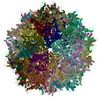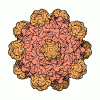+ Open data
Open data
- Basic information
Basic information
| Entry | Database: PDB / ID: 8ep2 | ||||||
|---|---|---|---|---|---|---|---|
| Title | The capsid structure of Aleutian Mink Disease Virus | ||||||
 Components Components | Capsid protein VP1 | ||||||
 Keywords Keywords | VIRUS LIKE PARTICLE / Parvovirus / Capsid / AMDV / cryo-EM / Amdoparvovirus / Pathogen | ||||||
| Function / homology |  Function and homology information Function and homology informationsymbiont entry into host cell via permeabilization of host membrane / T=1 icosahedral viral capsid / clathrin-dependent endocytosis of virus by host cell / host cell nucleus / virion attachment to host cell / structural molecule activity Similarity search - Function | ||||||
| Biological species |  Aleutian mink disease virus Aleutian mink disease virus | ||||||
| Method | ELECTRON MICROSCOPY / single particle reconstruction / cryo EM / Resolution: 2.37 Å | ||||||
 Authors Authors | Mietzsch, M. / McKenna, R. | ||||||
| Funding support |  United States, 1items United States, 1items
| ||||||
 Citation Citation |  Journal: Viruses / Year: 2022 Journal: Viruses / Year: 2022Title: Capsid Structure of Aleutian Mink Disease Virus and Human Parvovirus 4: New Faces in the Parvovirus Family Portrait. Authors: Renuk Lakshmanan / Mario Mietzsch / Alberto Jimenez Ybargollin / Paul Chipman / Xiaofeng Fu / Jianming Qiu / Maria Söderlund-Venermo / Robert McKenna /   Abstract: Parvoviruses are small, single-stranded DNA viruses with non-enveloped capsids. Determining the capsid structures provides a framework for annotating regions important to the viral life cycle. ...Parvoviruses are small, single-stranded DNA viruses with non-enveloped capsids. Determining the capsid structures provides a framework for annotating regions important to the viral life cycle. Aleutian mink disease virus (AMDV), a pathogen in minks, and human parvovirus 4 (PARV4), infecting humans, are parvoviruses belonging to the genera and , respectively. While Aleutian mink disease caused by AMDV is a major threat to mink farming, no clear clinical manifestations have been established following infection with PARV4 in humans. Here, the capsid structures of AMDV and PARV4 were determined via cryo-electron microscopy at 2.37 and 3.12 Å resolutions, respectively. Despite low amino acid sequence identities (10-30%) both viruses share the icosahedral nature of parvovirus capsids, with 60 viral proteins (VPs) assembling the capsid via two-, three-, and five-fold symmetry VP-related interactions, but display major structural variabilities in the surface loops when the capsid structures are superposed onto other parvoviruses. The capsid structures of AMDV and PARV4 will add to current knowledge of the structural platform for parvoviruses and permit future functional annotation of these viruses, which will help in understanding their infection mechanisms at a molecular level for the development of diagnostics and therapeutics. | ||||||
| History |
|
- Structure visualization
Structure visualization
| Structure viewer | Molecule:  Molmil Molmil Jmol/JSmol Jmol/JSmol |
|---|
- Downloads & links
Downloads & links
- Download
Download
| PDBx/mmCIF format |  8ep2.cif.gz 8ep2.cif.gz | 5.9 MB | Display |  PDBx/mmCIF format PDBx/mmCIF format |
|---|---|---|---|---|
| PDB format |  pdb8ep2.ent.gz pdb8ep2.ent.gz | Display |  PDB format PDB format | |
| PDBx/mmJSON format |  8ep2.json.gz 8ep2.json.gz | Tree view |  PDBx/mmJSON format PDBx/mmJSON format | |
| Others |  Other downloads Other downloads |
-Validation report
| Summary document |  8ep2_validation.pdf.gz 8ep2_validation.pdf.gz | 1.4 MB | Display |  wwPDB validaton report wwPDB validaton report |
|---|---|---|---|---|
| Full document |  8ep2_full_validation.pdf.gz 8ep2_full_validation.pdf.gz | 1.5 MB | Display | |
| Data in XML |  8ep2_validation.xml.gz 8ep2_validation.xml.gz | 702.7 KB | Display | |
| Data in CIF |  8ep2_validation.cif.gz 8ep2_validation.cif.gz | 1.1 MB | Display | |
| Arichive directory |  https://data.pdbj.org/pub/pdb/validation_reports/ep/8ep2 https://data.pdbj.org/pub/pdb/validation_reports/ep/8ep2 ftp://data.pdbj.org/pub/pdb/validation_reports/ep/8ep2 ftp://data.pdbj.org/pub/pdb/validation_reports/ep/8ep2 | HTTPS FTP |
-Related structure data
| Related structure data |  28514MC  8ep9C M: map data used to model this data C: citing same article ( |
|---|---|
| Similar structure data | Similarity search - Function & homology  F&H Search F&H Search |
- Links
Links
- Assembly
Assembly
| Deposited unit | 
|
|---|---|
| 1 |
|
- Components
Components
| #1: Protein | Mass: 73595.305 Da / Num. of mol.: 60 Source method: isolated from a genetically manipulated source Source: (gene. exp.)  Aleutian mink disease virus / Cell line (production host): Sf9 / Production host: Aleutian mink disease virus / Cell line (production host): Sf9 / Production host:  |
|---|
-Experimental details
-Experiment
| Experiment | Method: ELECTRON MICROSCOPY |
|---|---|
| EM experiment | Aggregation state: PARTICLE / 3D reconstruction method: single particle reconstruction |
- Sample preparation
Sample preparation
| Component | Name: Aleutian mink disease virus / Type: VIRUS / Entity ID: all / Source: RECOMBINANT |
|---|---|
| Source (natural) | Organism:  Aleutian mink disease virus Aleutian mink disease virus |
| Source (recombinant) | Organism:  |
| Details of virus | Empty: YES / Enveloped: NO / Isolate: STRAIN / Type: VIRUS-LIKE PARTICLE |
| Virus shell | Triangulation number (T number): 1 |
| Buffer solution | pH: 7.4 |
| Specimen | Embedding applied: NO / Shadowing applied: NO / Staining applied: NO / Vitrification applied: YES |
| Vitrification | Cryogen name: ETHANE |
- Electron microscopy imaging
Electron microscopy imaging
| Experimental equipment |  Model: Titan Krios / Image courtesy: FEI Company |
|---|---|
| Microscopy | Model: FEI TITAN KRIOS |
| Electron gun | Electron source:  FIELD EMISSION GUN / Accelerating voltage: 300 kV / Illumination mode: FLOOD BEAM FIELD EMISSION GUN / Accelerating voltage: 300 kV / Illumination mode: FLOOD BEAM |
| Electron lens | Mode: BRIGHT FIELD / Nominal defocus max: 2000 nm / Nominal defocus min: 500 nm |
| Image recording | Electron dose: 59 e/Å2 / Film or detector model: DIRECT ELECTRON APOLLO (4k x 4k) |
- Processing
Processing
| Software | Name: PHENIX / Version: 1.10-2155_2155: / Classification: refinement | ||||||||||||||||||||||||
|---|---|---|---|---|---|---|---|---|---|---|---|---|---|---|---|---|---|---|---|---|---|---|---|---|---|
| EM software | Name: cisTEM / Category: CTF correction | ||||||||||||||||||||||||
| CTF correction | Type: NONE | ||||||||||||||||||||||||
| 3D reconstruction | Resolution: 2.37 Å / Resolution method: FSC 0.143 CUT-OFF / Num. of particles: 93393 / Symmetry type: POINT | ||||||||||||||||||||||||
| Refine LS restraints |
|
 Movie
Movie Controller
Controller





 PDBj
PDBj


